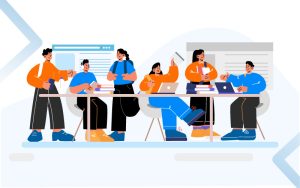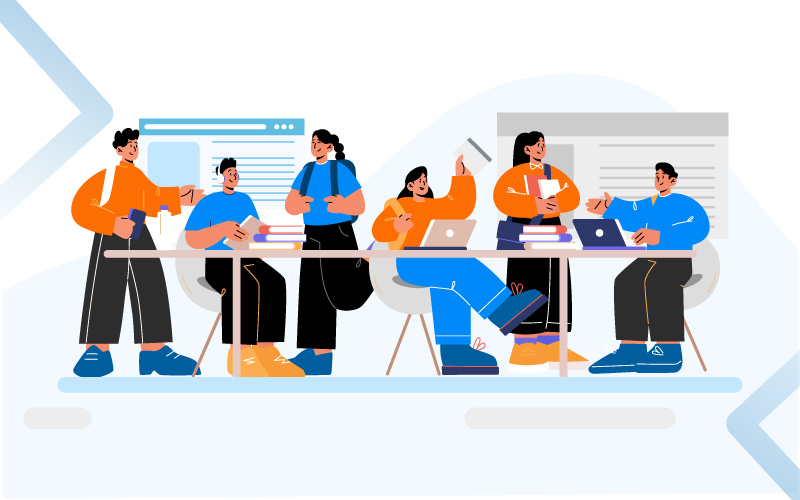In today’s digital-first learning environments, ensuring accessibility is not optional—it’s a legal requirement and a moral imperative. For K12 schools, the Web Content Accessibility Guidelines (WCAG) provide a robust framework for creating eLearning content that works for all learners, including those who are differently abled. Yet implementing WCAG 2.1/2.2 AA across curricula, technology platforms, and vendor relationships can feel daunting. This roadmap simplifies the process, offering an actionable, four-pillar strategy to weave WCAG into every facet of K12 digital learning. It also covers the legal landscape and the ROI related to WCAG implementation with links to articles covering some key steps in the implementation in further detail. First let’s look at why WCAG integration is much more than just compliance and legal mandates.
Beyond Compliance: How WCAG-Aligned Content Boosts Engagement for All Learners
Accessibility extends past legal mandates. When K12 institutions embed WCAG principles into the content they develop, they create more inclusive, engaging, and effective learning experiences—for all students:
- Captions Support ESL and Hard-of-Hearing Learners
Captions do more than just make content accessible for students with hearing impairments—they also help English language learners (ELLs) follow along more easily. Adding accurate, synchronized captions (as recommended in WCAG 1.2.2 and 1.2.4) to videos, screencasts, and podcasts can improve comprehension for ELLs by 15–20% and boost retention for hard-of-hearing students. - Alt Text Helps Visually Impaired Learners—and Builds Literacy for Everyone
Good alt text (WCAG 1.1.1) is a win for everyone. It describes images for screen-reader users, ensuring no one misses important visual content. But it also benefits sighted students by reinforcing descriptive writing and vocabulary skills. For example: “A 1914 map of Europe highlighting the Austro-Hungarian Empire in blue, with neighboring countries labeled in red” helps students visualize and learn. - Universal Design for Learning Meets WCAG
WCAG guidelines naturally align with Universal Design for Learning (UDL), which encourages multiple ways to engage with content. Features like adjustable text size (WCAG 1.4.4), strong color contrast (WCAG 1.4.3), and keyboard-friendly navigation (WCAG 2.1.1) support students with dyslexia, visual impairments, or motor challenges—while also improving usability for everyone.
When educators move beyond just “meeting standards” and start designing with every learner in mind, the results are powerful: greater engagement, deeper understanding, and fewer barriers for all.
Legal Landscape: Navigating Federal, State, and International Mandates
While moral imperatives and pedagogical benefits drive WCAG adoption, strict legal frameworks also govern K12 accessibility. Understanding these federal, state, and international mandates is key before tackling the technical side of WCAG compliance.
- Americans with Disabilities Act (ADA)
Under Title II of the ADA, public institutions—including K–12 schools—must ensure equal access to all programs and services. Courts have interpreted this to include websites, mobile apps, and digital learning tools. While the ADA doesn’t name WCAG specifically, WCAG 2.0 or 2.1 AA is widely recognized by federal agencies as the standard schools should follow. - Section 504 & Section 508 of the Rehabilitation Act
- Section 504 prohibits discrimination against students with disabilities by any entity receiving federal funds. If digital content isn’t accessible, it may be seen as a failure to provide Free Appropriate Public Education (FAPE).
- Section 508 applies to federal agencies but sets a technical precedent for accessibility. Its standards, which reference WCAG 2.0 AA, often guide K–12 districts that rely on federal funding or use federally approved platforms.
- EU Web Accessibility Directive (2016/2102)
For international schools or U.S. schools serving EU-based families, the EU requires compliance with WCAG 2.0 AA (increasingly updated to 2.1 AA). Member countries enforce this directive through national regulations, meaning any content provider or LMS vendor serving the EU must comply—or face legal consequences. - Illinois House Bill 26 (HB 26)
Since August 1, 2022, Illinois public schools must ensure that all third-party educational content meets WCAG 2.0 AA standards—now moving toward WCAG 2.1 AA. Vendors supplying textbooks, assessments, or digital learning tools must show proof of compliance. Noncompliance may lead to fines and state-mandated corrective actions. - Other State and Municipal Laws
- California AB 434: Requires WCAG 2.1 AA compliance for K–12 school websites and vendor-provided content by 2024.
- New York City Local Law 144: Applies WCAG 2.1 AA standards to private K–12 schools that receive public funds.
To learn how these laws influence procurement, curriculum development, and technology planning, check out our blog: Demystifying Legal WCAG Compliance for K–12 Schools.
The 4-Pillar WCAG Strategy for K12 eLearning
To make WCAG guidelines actionable for K12 education, we organize them around four foundational pillars: Perceivable, Operable, Understandable, and Robust. Each pillar addresses a key dimension of accessibility and helps ensure inclusive digital learning experiences for all students.
1. Perceivable
Goal: Ensure all learners can access content through senses (see or hear).
Alt-Text (WCAG 1.1.1)
Every instructional image—charts, infographics, diagrams—must include descriptive alternative text. For complex visuals, extended descriptions or a link to a detailed explanation must be provided.
Captions and Transcripts (WCAG 1.2.2/1.2.4/1.2.5)
- Synchronized Captions (1.2.2): Mandatory for all pre-recorded videos.
- Live Captioning (1.2.4): Crucial for real-time/synchronous virtual lessons (e.g., Zoom, Microsoft Teams).
- Audio Descriptions (1.2.5): Use toggleable narration to describe key visual elements in video.
Color Contrast (WCAG 1.4.3)
Ensure text and interactive elements have at least a 4.5:1 contrast ratio for readability. Tools like WebAIM’s Contrast Checker can help maintain accessibility without sacrificing visual design.
Text Resize (WCAG 1.4.4)
Allow users to enlarge text up to 200% without loss of content or functionality. This supports students with low vision or reading difficulties.
Responsive Layouts (WCAG 1.4.10)
Design content that adapts gracefully to various screen sizes. K12 learners often use tablets or Chromebooks, so layouts must reflow logically when zoomed or viewed on smaller devices.
👉 Explore more: Step-by-Step WCAG Audits for Existing eLearning Content.
2. Operable
Goal: Users must be able to navigate and interact with content using keyboard or other assistive devices.
Keyboard Navigation (WCAG 2.1.1)
All interactive elements—menus, links, form fields, media players—must be fully accessible via keyboard alone. This ensures inclusivity for students using alternative input devices.
Focus Indicators (WCAG 2.4.7)
Visible focus styles (e.g., borders or highlights) enable students relying on keyboard navigation to see which element is active. Custom styles that reflect individual brands are fine, as long as they’re high-contrast and easy to spot.
Time-Flexible Assessments (WCAG 2.2.1)
Offer flexible timing options on quizzes and tests, accommodating those who need more time to process or type responses. This is especially important in K12 for students who require more time due to learning differences or processing needs.
Bypass Blocks (WCAG 2.4.1/2.4.6)
Enable learners using screen readers to skip repetitive navigation. Add “Skip to Main Content” links and structure content with clear section headings.
Responsive Gestures (WCAG 2.5.1/2.5.2)
On touch devices, ensure all interactive controls are large enough (minimum 44×44 px) and spaced to prevent accidental taps—a common issue for younger learners.
👉 Learn more: “Designing New Content with WCAG-by-Default.”
3. Understandable
Goal: Content structure and language must be clear, predictable and easy to follow.
Consistent Navigation (WCAG 3.2.3)
K12 websites, LMS platforms and eLearning modules should maintain consistent menu structures, button placements and labeling conventions across pages. Predictable structures reduce cognitive load and confusion.
Readable Language (WCAG 3.1.5)
Use plain, age-appropriate language for K12 learners. Avoid jargon or overly complex sentences. When advanced terms are necessary, define them using tooltips, glossaries, or in-margin notes.
Error Suggestions (WCAG 3.3.3)
Help learners correct mistakes. Use helpful, context-specific error messages like “Please select your grade level” instead of vague alerts like “Error occurred.”
Tools like Microsoft’s Seeing AI assist visually impaired students by converting diagrams into audio descriptions, while AR platforms like Merge EDU offer tactile experiences for neurodiverse learners.
Predictable Interfaces (WCAG 3.2.2)
Avoid sudden focus changes or unexpected popups. Make sure modal dialogs and dynamic elements behave in ways students can anticipate.
Input Assistance (WCAG 3.3.1)
Label form fields clearly (e.g., “First Name,” “Parent Contact Info”) and group related inputs using semantic HTML or ARIA roles, so screen readers convey them accurately.
👉 Further reading: Translating IEPs into WCAG-Aligned Digital Accommodation.
4. Robust
Goal: Ensure content remains accessible across platforms, devices, and future technologies.
- Semantic HTML5 (WCAG 4.1.1/4.1.2)
Use correct HTML tags and ARIA roles to communicate structure to screen readers like JAWS and NVDA so that they can accurately parse and convey structure.
For example, wrap quizzes in<section role="region" aria-labelledby="quiz-title">to make them navigable by assistive tech. - LMS Compatibility
Ensure your chosen Learning Management System (e.g., Canvas, Moodle, Blackboard) is WCAG 2.1/2.2 AA–compatible. Conduct screen-reader tests: navigate every assignment, quiz, and discussion forum with NVDA or VoiceOver. - Future-Proof Markup
Avoid vendor-locked, proprietary widgets. Use open web standards (JavaScript libraries that follow ARIA guidelines). Monitor new assistive technologies; for instance, ARIA 1.2 and the upcoming WCAG 2.2 guidelines may introduce new roles and properties. - Cross-Browser Support
Test content on Chrome, Firefox, Edge, Safari, and target older versions still used in some districts. Ensure PDFs, Word docs, and other downloadable materials open correctly in screen readers (mobile and desktop).
Link: Discover how Assistive Tech and WCAG intersect in “Assistive Tech & WCAG: Bridging the Gap.”
ROI Analysis: Proactive Design vs. Retrofitting and Litigation Risks
Investing in WCAG from project inception yields measurable returns, often far exceeding the costs of retrofitting inaccessible content later:
- Lower Remediation Costs
A 2018 study by Deque Systems found that retrofitting an inaccessible website costs 20–50% more than integrating accessibility during initial design. In a K12 context, rebuilding modules, re-recording videos with captions, and rewriting inaccessible HTML can quickly balloon into tens of thousands of dollars district-wide. - Reduced Litigation Risk
The Office for Civil Rights (OCR) reported a 96% rise in digital accessibility complaints between 2017 and 2021. Lawsuits can saddle districts with legal fees, mandated remediation plans, and reputational harm. Proactively aligning with WCAG AA demonstrates good faith and can preclude OCR investigations. - Enhanced Student Retention & Outcomes
Studies show that accessible content correlates with 10–15% higher course completion rates among learners with disabilities. Better engagement translates to improved academic performance—a direct indicator of instructional effectiveness. - Broader Community Benefits
Accessible K12 content often proves beneficial for English language learners, students with temporary injuries, and families accessing homework online. Districts that brand themselves as “Inclusive and Accessible” can attract families and secure grants focused on equity.
For a step-by-step guide on auditing your existing content’s ROI, see our blog “Step-by-Step WCAG Audits for Existing eLearning Content.”
Conclusion
The path to full WCAG compliance in K12 eLearning is both an ethical responsibility and a strategic advantage. When districts adopt this four-pillar strategy—Perceivable, Operable, Understandable, Robust—they unlock a virtuous cycle of enhanced student engagement, reduced legal risk, and long-term cost savings. By proactively building accessibility into curricula, vetting vendors rigorously, training educators, and leveraging AI-powered tools, K12 schools can future-proof their digital learning ecosystems.
Use this Ultimate K-12 WCAG Implementation Roadmap as your foundational guide. Then dive into the specialized blogs in this cluster for granular how-tos, checklists, and best practices—ensuring every student, regardless of ability, has equitable access to 21st-century learning.
To read in further detail about WCAG implementation for K12 content, check out the blogs below:
- Demystifying Legal WCAG Compliance for K-12 Schools
- Step-by-Step WCAG Audits for Existing eLearning Content
- Accessible eLearning Design: WCAG by Default
- Assistive Tech & WCAG: Bridging the Gap
- Translating IEPs into WCAG-Aligned Digital Accommodation
- The Vendor Selection Playbook: WCAG as a Non-Negotiable
- Training Educators as WCAG Champions
- Future-Proofing with WCAG 2.2 & AI
References
- Illinois’ New Digital Accessibility Law Benefits Students with Disabilities, Digital Accessibility Illinois Blog, 21 July 2022. https://www.boia.org/blog/illinois-new-digital-accessibility-law-benefits-students-with-disabilities boia.orgltcillinois.org
- Web Accessibility Directive — Standards and Harmonisation, European Commission, 2023. https://digital-strategy.ec.europa.eu/en/policies/web-accessibility-directive-standards-and-harmonisation digital-strategy.ec.europa.eueur-lex.europa.eu
- The ROI Of eLearning: Using Data To Justify Investments, eLearning Industry, 2024. https://elearningindustry.com/proving-roi-using-data-to-justify-investments-in-elearning elearningindustry.com
- VPAT Report: Essential Accessibility Documentation for 2025, WCAG Solutions. https://www.wcag.com/solutions/vpat-accessibility-documentation/ wcag.com
- Illinois Passes Law to Require Digital Accessibility in all K-12 Schools, Digital Learning Collab, 16 Sept 2021. https://www.digitallearningcollab.com/blog/2021/9/16/illinois-passes-law-to-require-digital-accessibility-in-all-k-12-schools digitallearningcollab.com
- VPAT Evaluation Scoring for RFPs, v 3.0, Minnesota State Portal, 2021. https://mn.gov/mnit/assets/VPAT-EvaluationScoring-for-RFPs_tcm38-559794.pdf mn.gov
- European Union | Web Accessibility Initiative (WAI) | W3C, W3C, 2022. https://www.w3.org/WAI/policies/european-union/ w3.org
- Risk Reduction and Cost Savings: The Advantages of Retrofitting, SFBay Engineering, 12 Mar 2024. https://sfbayengineering.com/2024/03/12/retrofitting-advantages-cost-savings/ sfbayengineering.com
- Illinois 2021-2022 | SCH CD-INTERNET ACCESSIBILITY (HB 26), TrackBill. https://trackbill.com/bill/illinois-house-bill-26-sch-cd-internet-accessibility/1978129/ trackbill.com
- Acquisition Guidance on the Voluntary Product Accessibility Template (VPAT), HHS Section 508, 2020. https://www.hhs.gov/web/section-508/contracting/technology-products/product-accessibility-template/index.html hhs.gov
- Estimating the Return on Investment for Instructional Improvement, ACUE & Ithaka S+R, 2019. https://acue.org/wp-content/uploads/2019/03/Estimating-ROI-Instructional-Improvement-Ithaka.pdf acue.org
- Debdut Pramanickhttps://www.mitrmedia.com/resources/blogs/author/debdutp/
- Debdut Pramanickhttps://www.mitrmedia.com/resources/blogs/author/debdutp/
- Debdut Pramanickhttps://www.mitrmedia.com/resources/blogs/author/debdutp/
- Debdut Pramanickhttps://www.mitrmedia.com/resources/blogs/author/debdutp/









